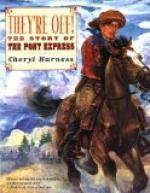Nevertheless, Ficklin confided his scheme enthusiastically to Senator Gwin, at the same time pointing out the benefits that would accrue to California should it ever be put into execution. The Senator at once saw the merits of the plan and quickly caught the contagion. Not only was he enough of a statesman to appreciate the worth of a fast mail line across the continent, but he was also a good enough politician to realize that his position with his constituents and the country at large might be greatly strengthened were he to champion the enactment of a popular measure that would encourage the building of such a line through the aid of a Federal subsidy.
So in January, 1855, Gwin introduced in the Senate a bill which proposed to establish a weekly letter express service between St. Louis and San Francisco. The express was to operate on a ten-day schedule, follow the Central Route, and was to receive a compensation not exceeding $500.00 for each round trip. This bill was referred to the Committee on Military Affairs where it was quietly tabled and “killed.”
For the next five years the attention of Congress was largely taken up with the anti-slavery troubles that led to secession and war. Although the people of the West, and the Pacific Coast in particular, continued to agitate the need of a new and quick through mail service, for a long time little was done. It has been claimed that southern representatives in Congress during the decade before the war managed to prevent any legislation favorable to overland mail routes running North of the slave-holding states; and that they concentrated their strength to render government aid to the southern routes whenever possible.
At that time there were three generally recognized lines of mail traffic, of which the Panama line was by far the most important. Next came the so-called southern or “Butterfield” route which started from St. Louis and ran far to the southward, entering California from the extreme southeast corner of the state; a goodly amount of mail being sent in this direction. The Central route followed the Platte River into Wyoming and reached Sacramento via Salt Lake City, almost from a due easterly direction. On account of its location this route or trail could be easily controlled by the North in case of war. It had received very meagre support from the Government, and carried as a rule, only local mail. While the most direct route to San Francisco, it had been rendered the least important. This was not due solely to Congressional manipulation. Because of its northern latitude and the numerous high mountain ranges it traversed, this course was often blockaded with deep snows and was generally regarded as extremely difficult of access during the winter months.




